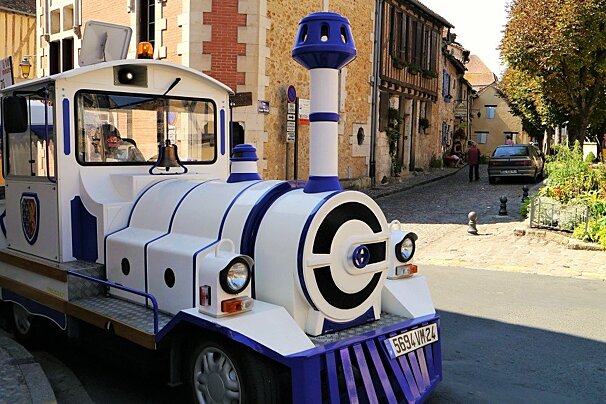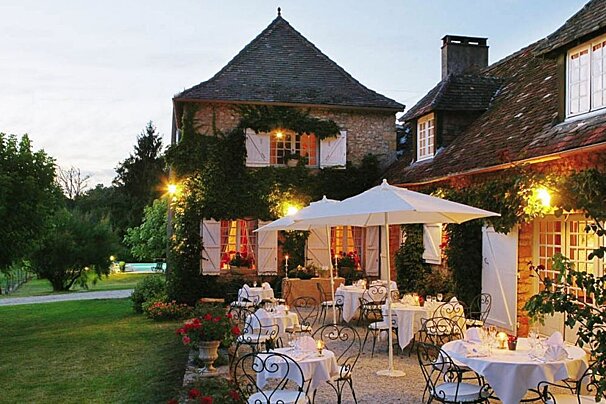
La Foret des Ecureuils Adventure Park, Sarlat-la-Caneda
From tree climbing to paintballing and even via ferrata, the Foret des Ecureuils Adventure Park has plenty of offer all ages.

© Baguetteshandlebars
Sunday market in Saint Cyprien, every week thoroughout the year
On Sunday mornings all year round this is a popular market.
The winding streets of the hillside town of Saint-Cyprien turn into a delightful and popular food market selling local produce and local wines. A great place to pick up picnic food. This is a very popular french market in the Dordogne.

From tree climbing to paintballing and even via ferrata, the Foret des Ecureuils Adventure Park has plenty of offer all ages.

Easy canoeing for everybody. You can navigate with family or friends in peace. You’ll be given a solid equipment, stable canoes and buoyancy aids.

This is a great outing for a family as you will have the chance to see these magnificent wild boar in a natural environment where they forage and feed in the forests of oak and chestnut trees.

Open Monday to Saturday all year round this horse riding centre welcomes you for lessons as well as trekking.

Discover the historic town of Bergerac during this 30-35 minute tour of the towns most famous sights and features.

A great place for a family day out and to escape the pre-historic world of the Dordogne...instead, enjoy the family atmosphere and displays of this fresh water aquarium.

This elegant and sophisticated two Michelin star restaurant offers creative dishes designed by chef Cédric Béchade, who plays with colours and textures in his cuisine.

The dining rooms allow for views of the surrounding vineyards and rolling hills. Drinks can also be enjoyed in the small library or among the chestnut trees.

Set in the hotel's 19th Century building, the dining room has wonderful stone walls and comforting, traditional table settings. Weather permitting, you may be able to relish your meal outside on the flowery terrace overlooking the lush garden or even down by the pool.

Stone walls, high ceilings, charming surroundings and elegant table settings lure you into the restaurant, with precise modern day interpretations of classic regional food, made from the finest local produce.

This restaurant in the old guard rooms of the Château du Viguier Royal, makes this old mansion-house kitchen alive again. The chef, Daniel Authié, creates cooking art which mixes contemporary and traditional flavours. The sommelier and head waiter, Bernard Badia, offers helpful advice on the food characteristics and complementary wines.

Offering a generous choice of traditional French dishes and a large wine selection, this restaurant is located in the heart of the picturesque town of Saint-Émilion. Diners can be accommodated in its intimate dining room, its small terrace, or a special table in its wine cellar carved out of the rock.
The beautiful Abbeye de Beaulieu-en-Rouergue was established in 1144 in the valley of the Seye by the Bishop of Rodez. This Cistercian abbey had a successful existence for many years and was expanded in the 17th and 18th centuries. It went into decline as the monastic discipline was relaxed but was saved from ruin in 1960 when it was subject to extensive renovation and turned into a contemporary arts centre which holds a number of temporary exhibitions each year.
Founded by Saint Didier in the 7th century, this abbey really didn't flourish until the 11th century when the town was linked to the Anney of Cluny.
In Cajarc, the George Pompidou arts centre holds a number of significant art exhibitions each year designed at promoting new trends in contemporary art. It was founded in 1989 and named after the former Prime Minister who spent time here.
Originally built by the lords of La Popie from the 9th century onwards, the château was sold to the de Gourdon family in the 12th century where it remained until the 17th century. Significant restoration work was undertaken in the late 19th and early 20th centuries to maintain this Renaissance palace. Today, a number of Renaissance frescoes discovered over the years can be viewed in its rooms.
This prehistoric cave is situated on a limestone plateau in the Lot valley, in an area speckled with prehistoric remains and megalithic monuments. The cave was discovered in 1965 and is a remarkable subterranean museum. Over 400 metres in length, it preserves human footprints, clay quarries, fireplaces, tools, and many bones. Some of the cave network was used as tombs; nearly 30 skeletons have been discovered dating as far back as the Copper Age. There is also a museum with a good archaeological collection.
This museum is dedicated to Figeac-born Egyptologist Jean-François Champollion who was the first person to interpret Egyptian hieroglyphics from the Rosetta Stone in 1822. As well as charting the course of his short life, this museum depicts the history of script from a number of different languages and has a collection of ancient Egyptian relics.